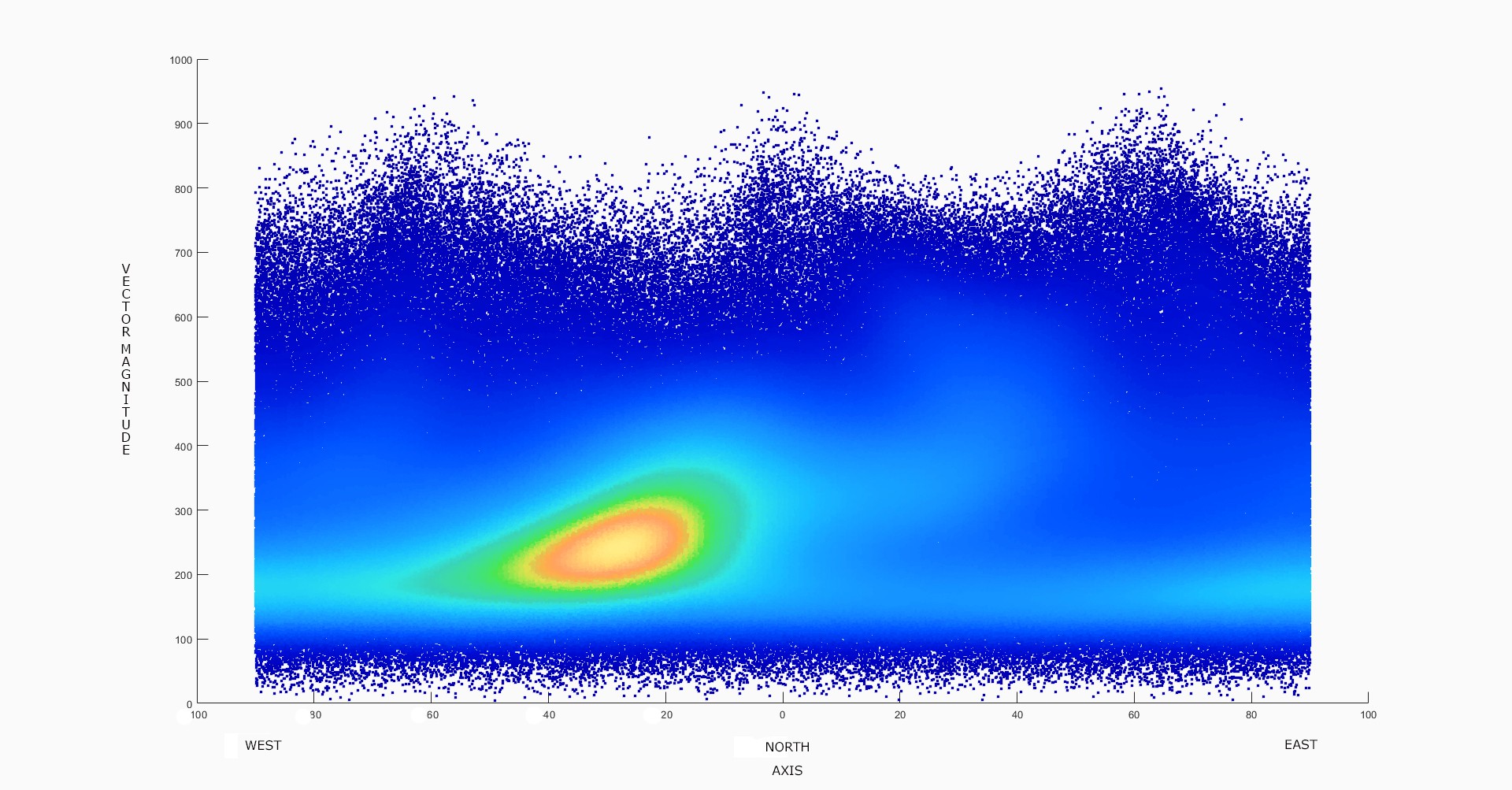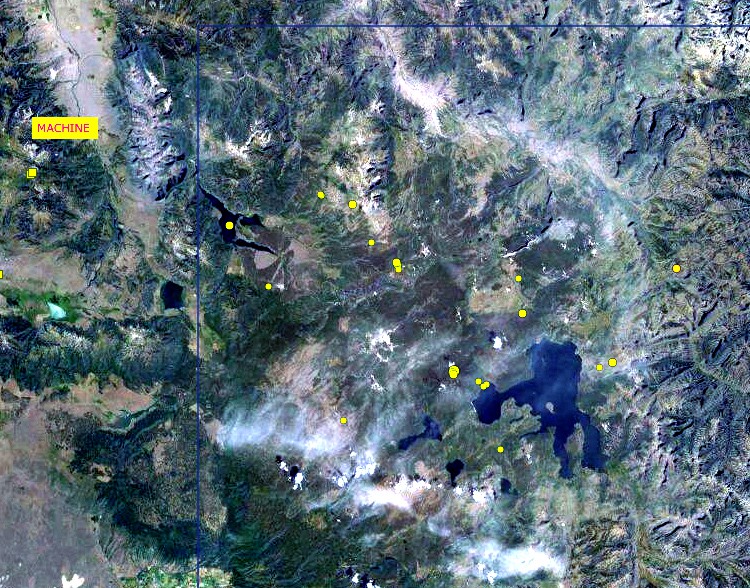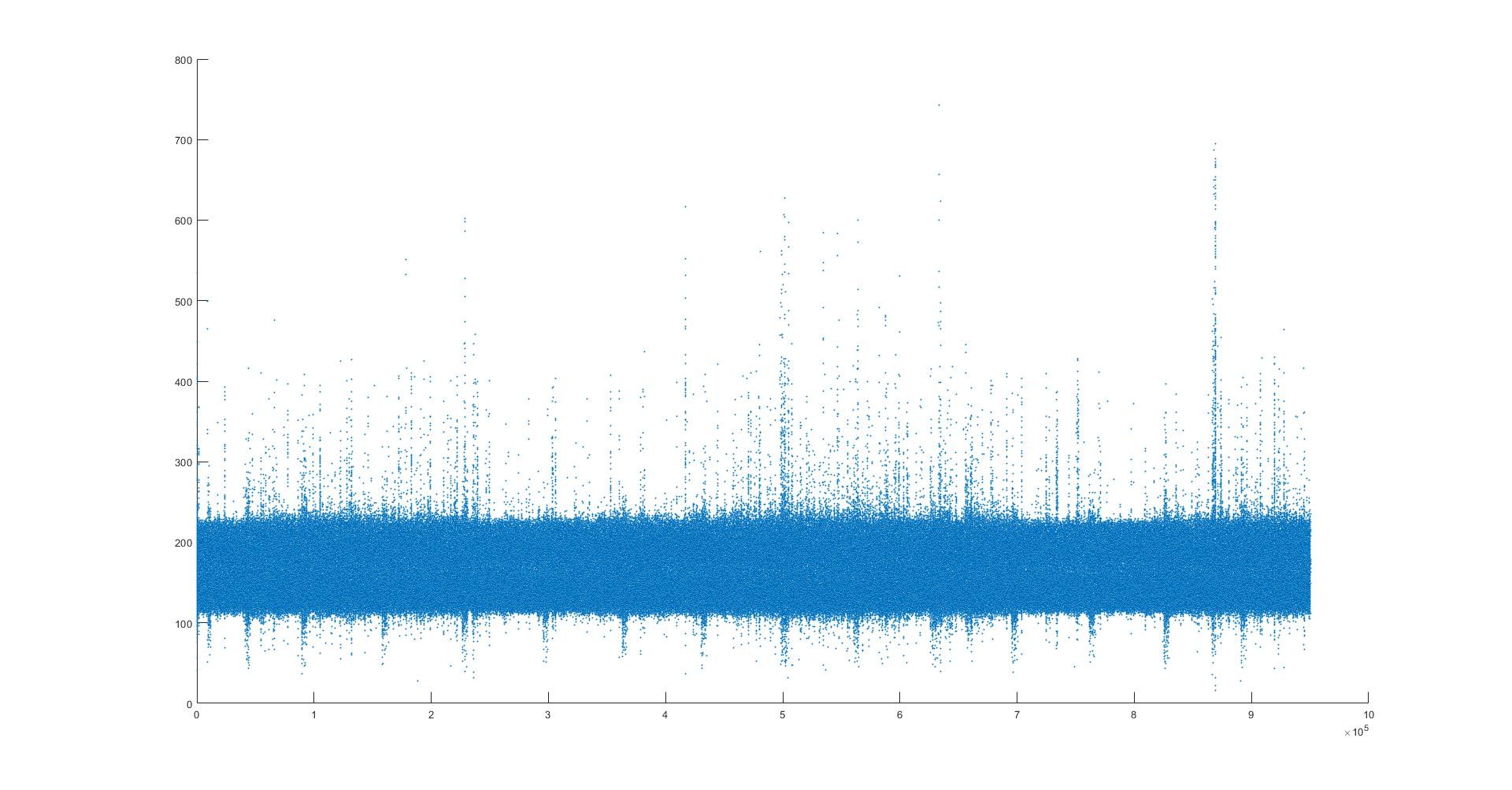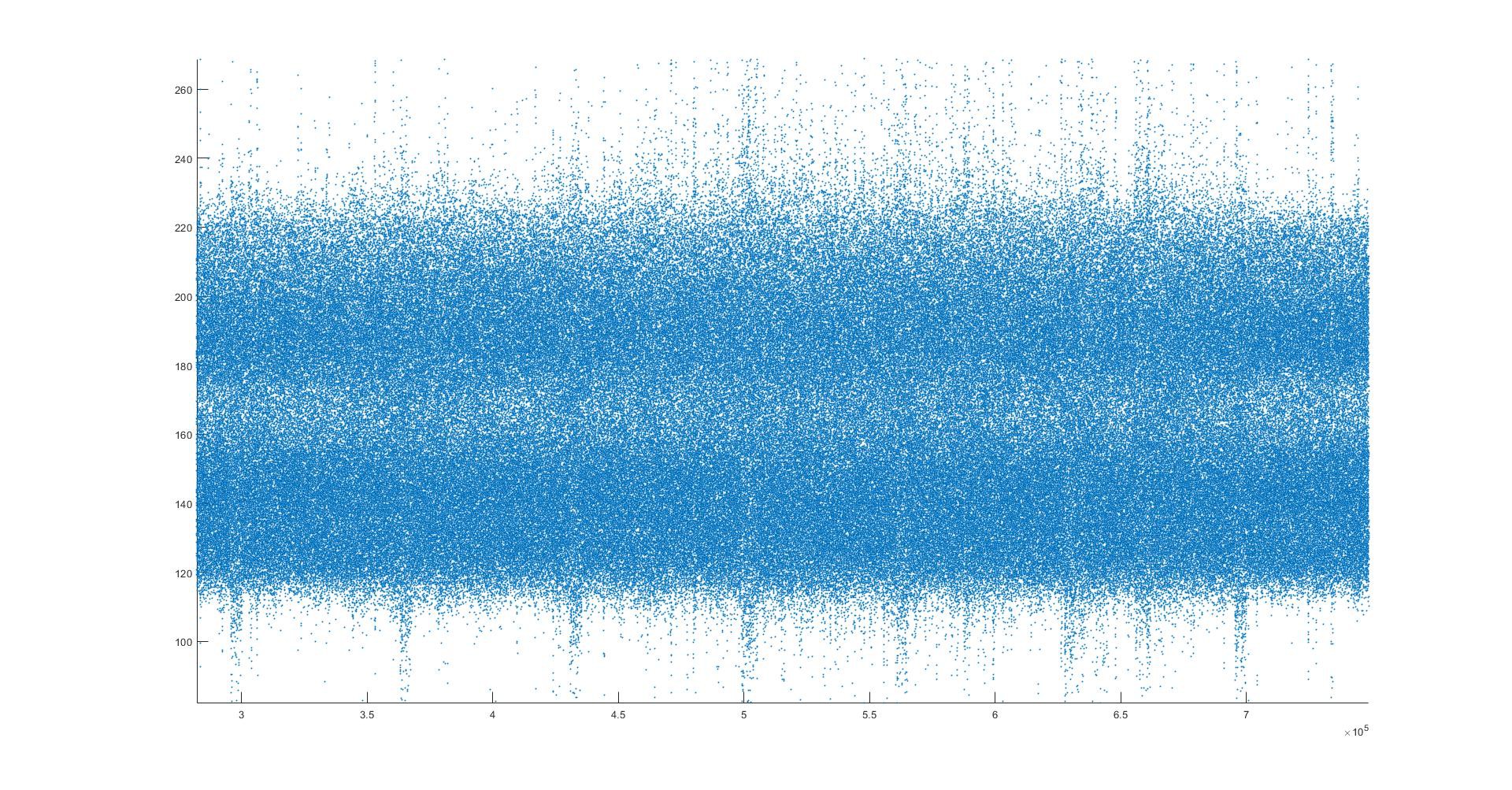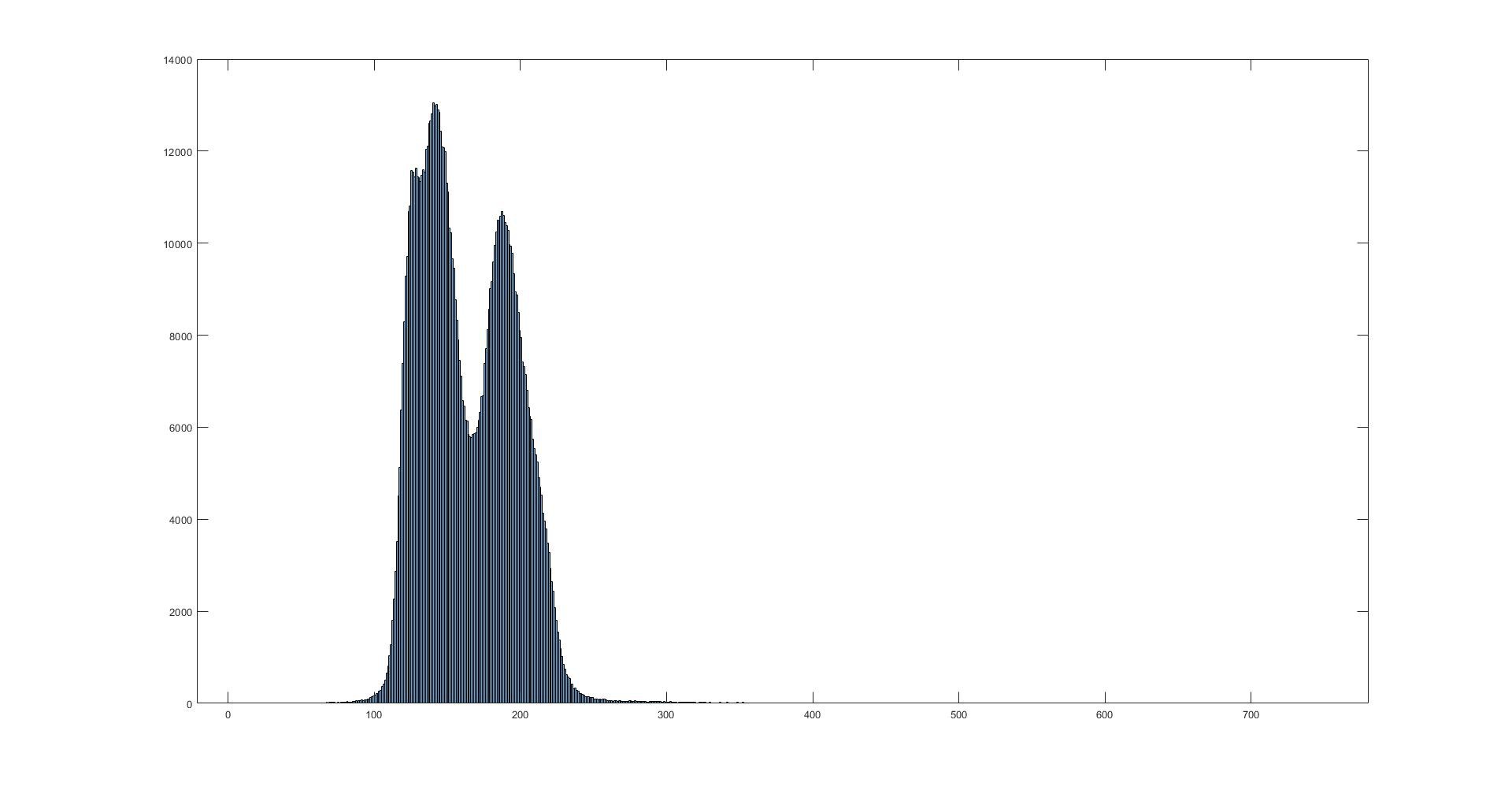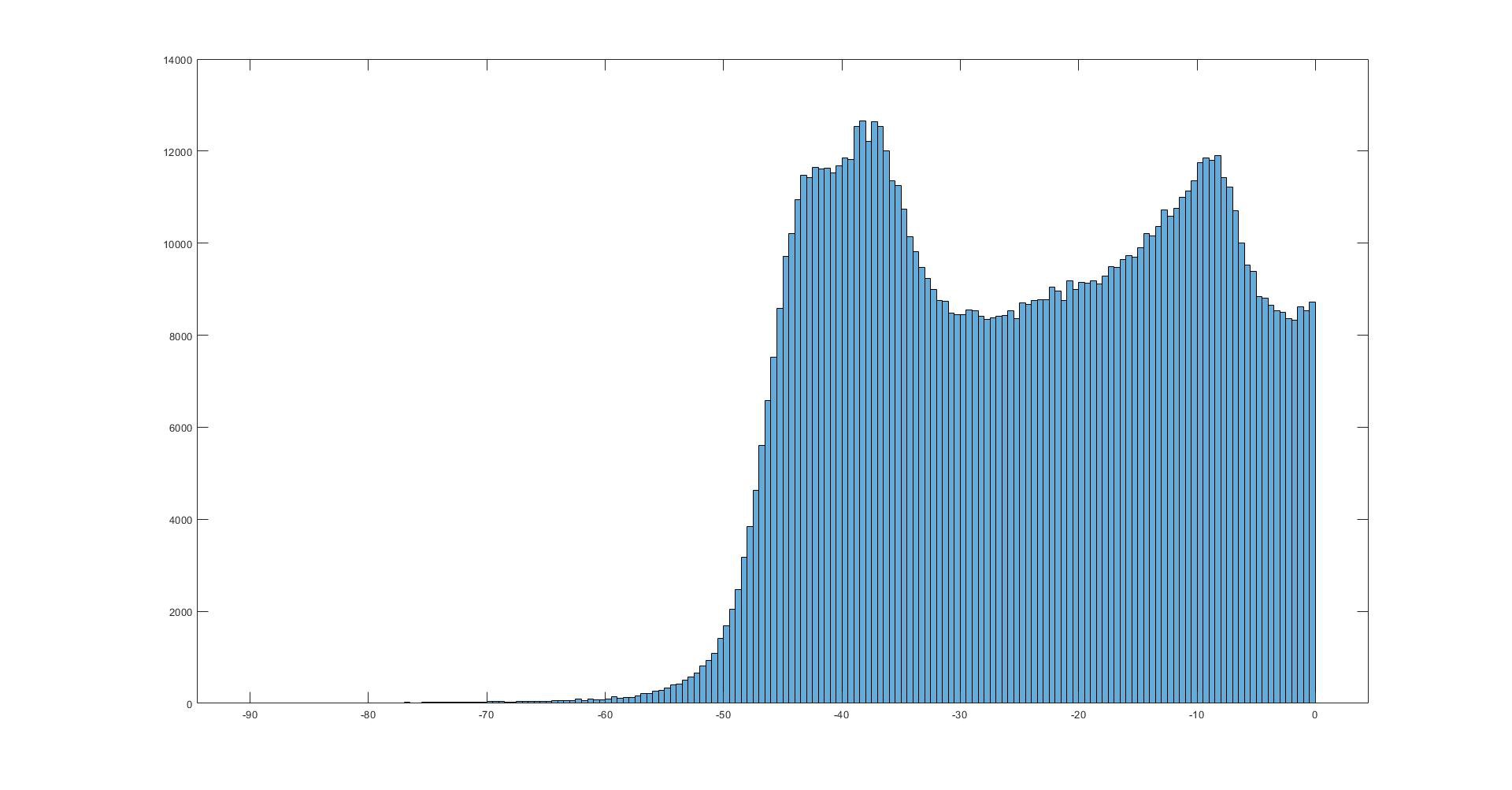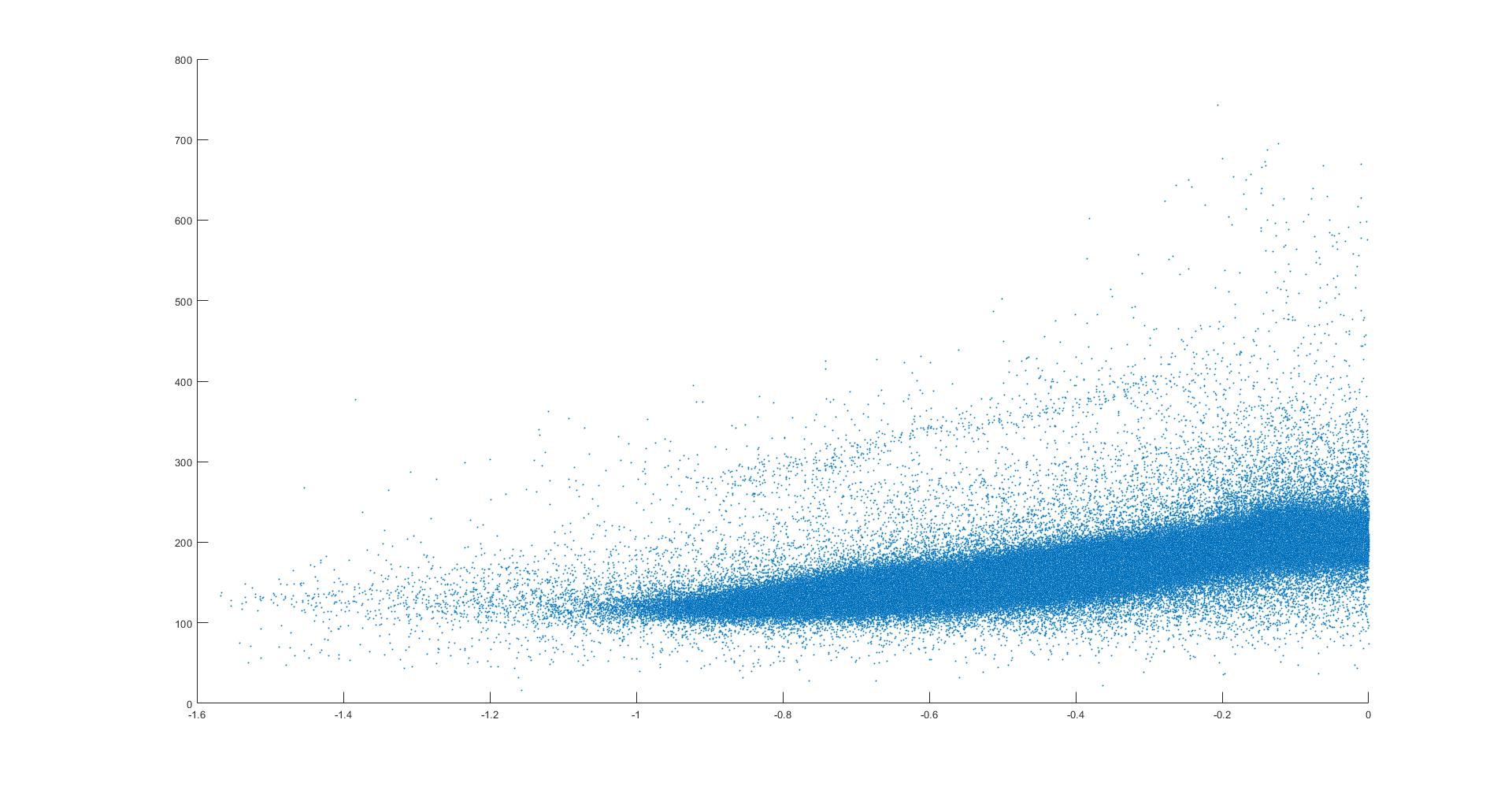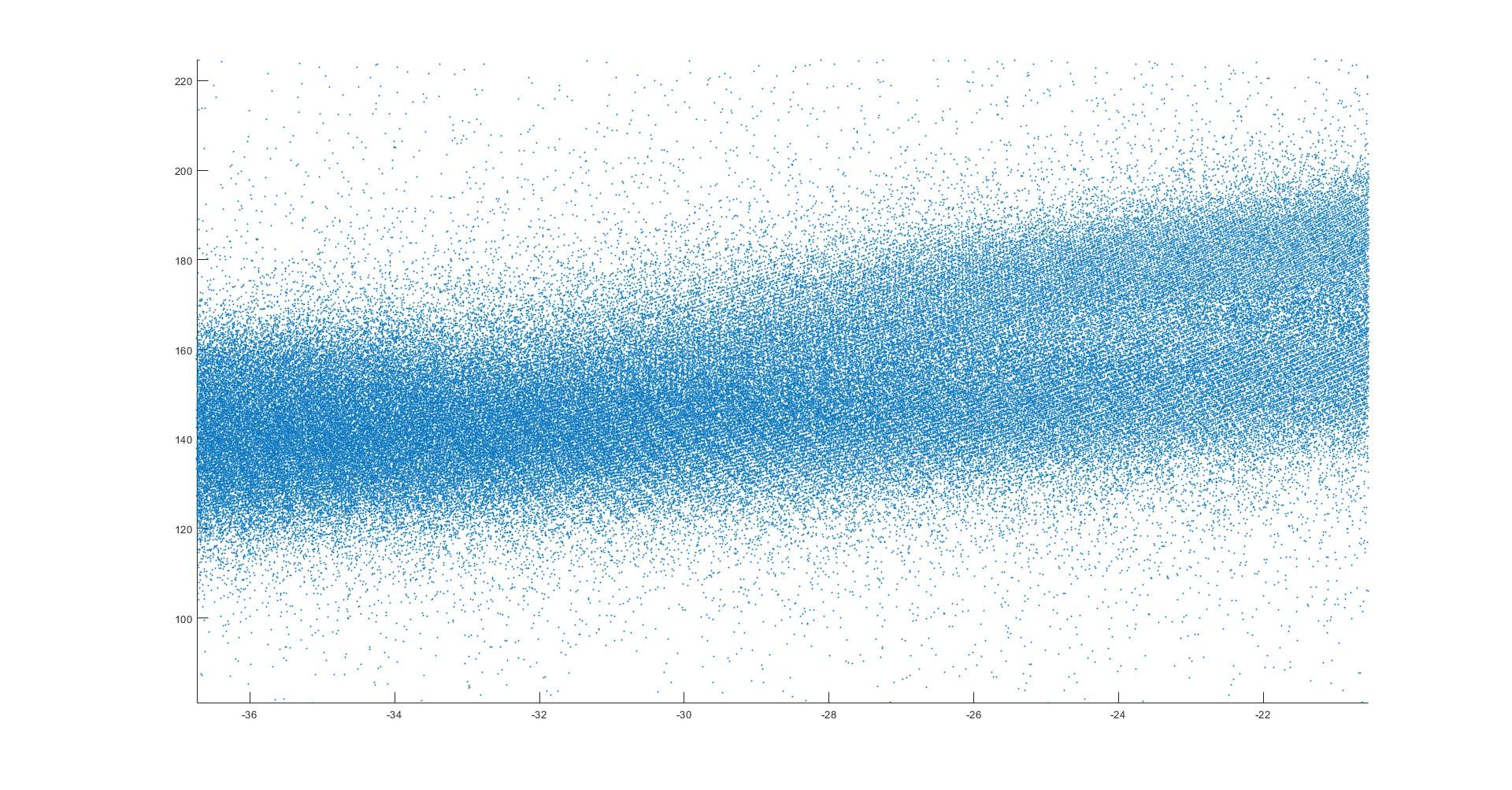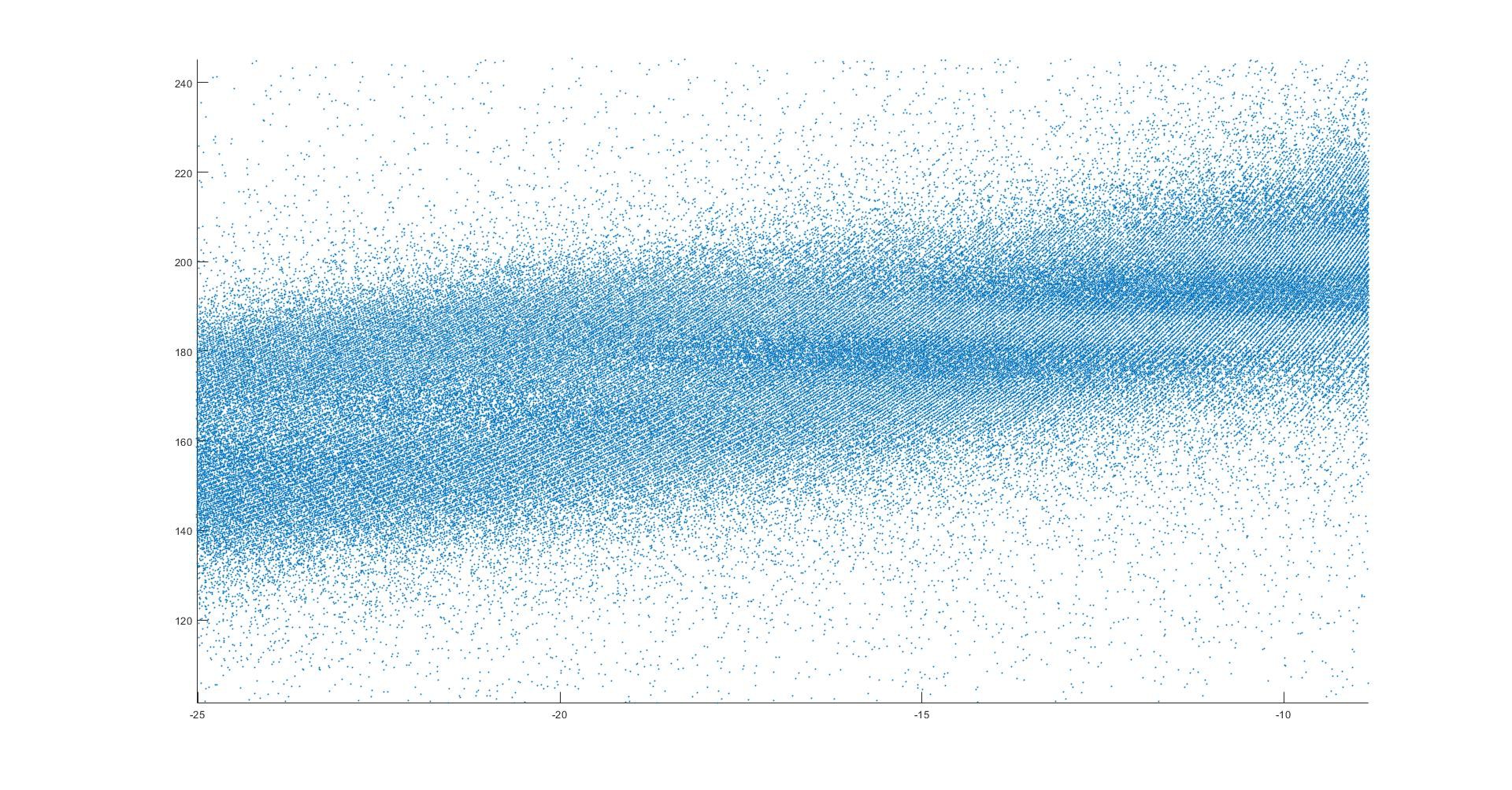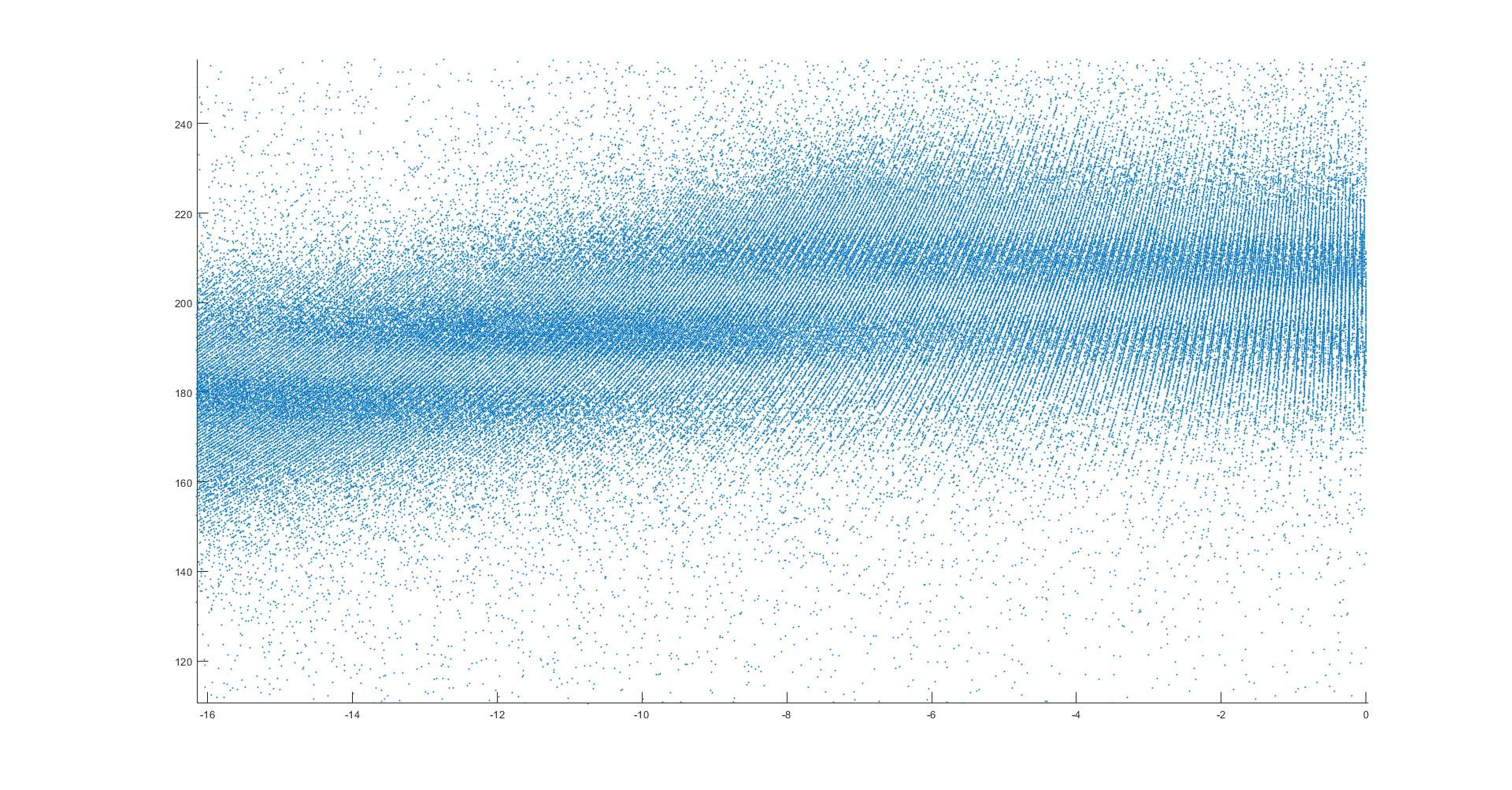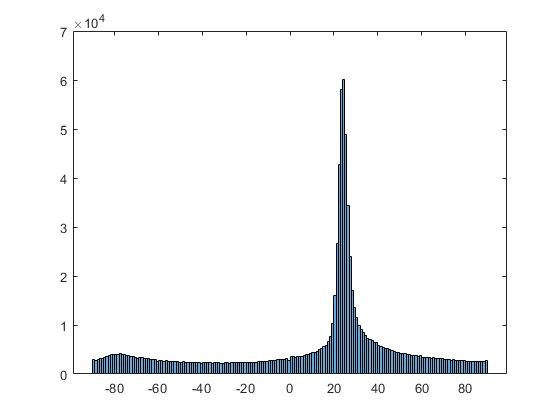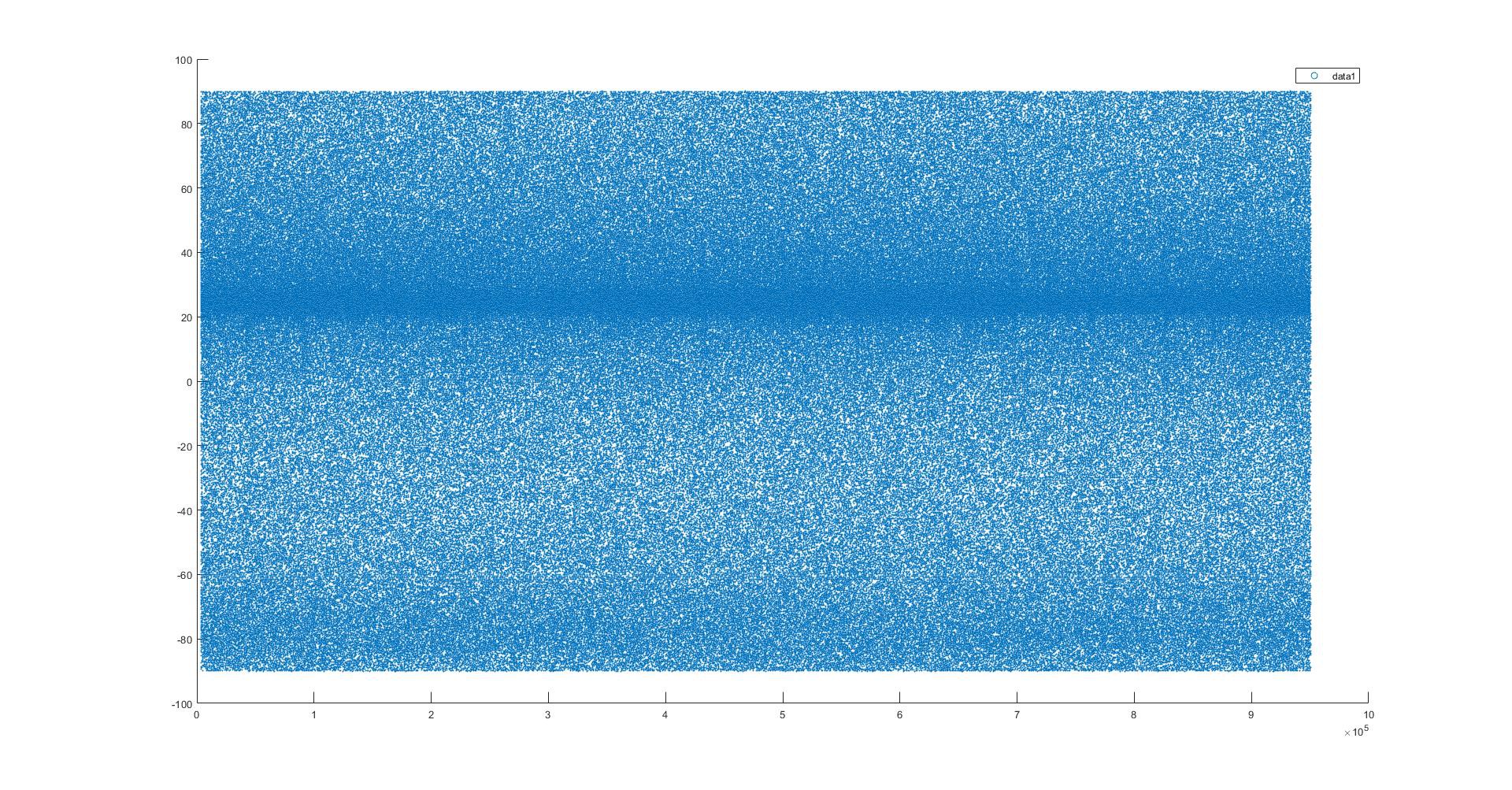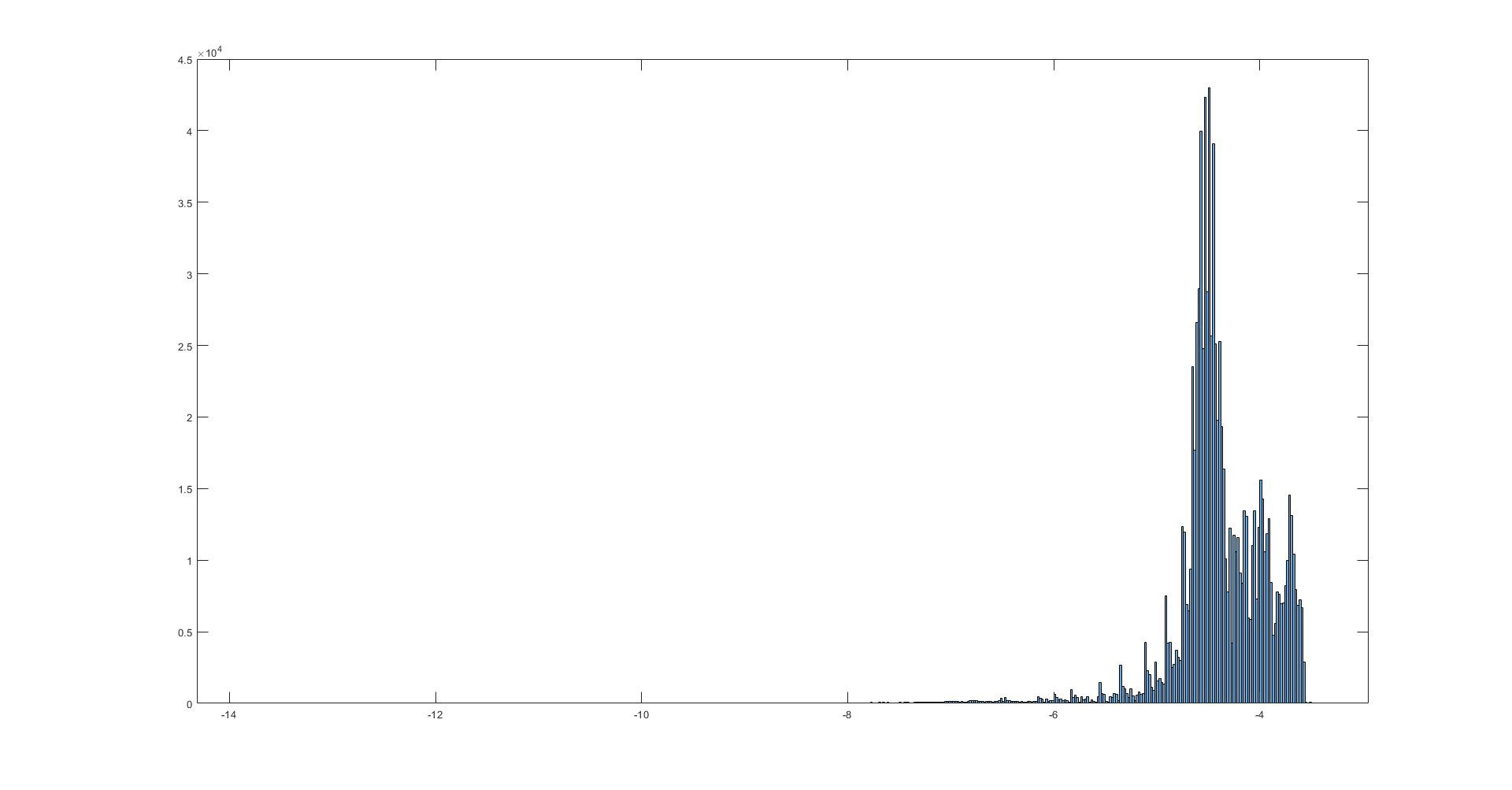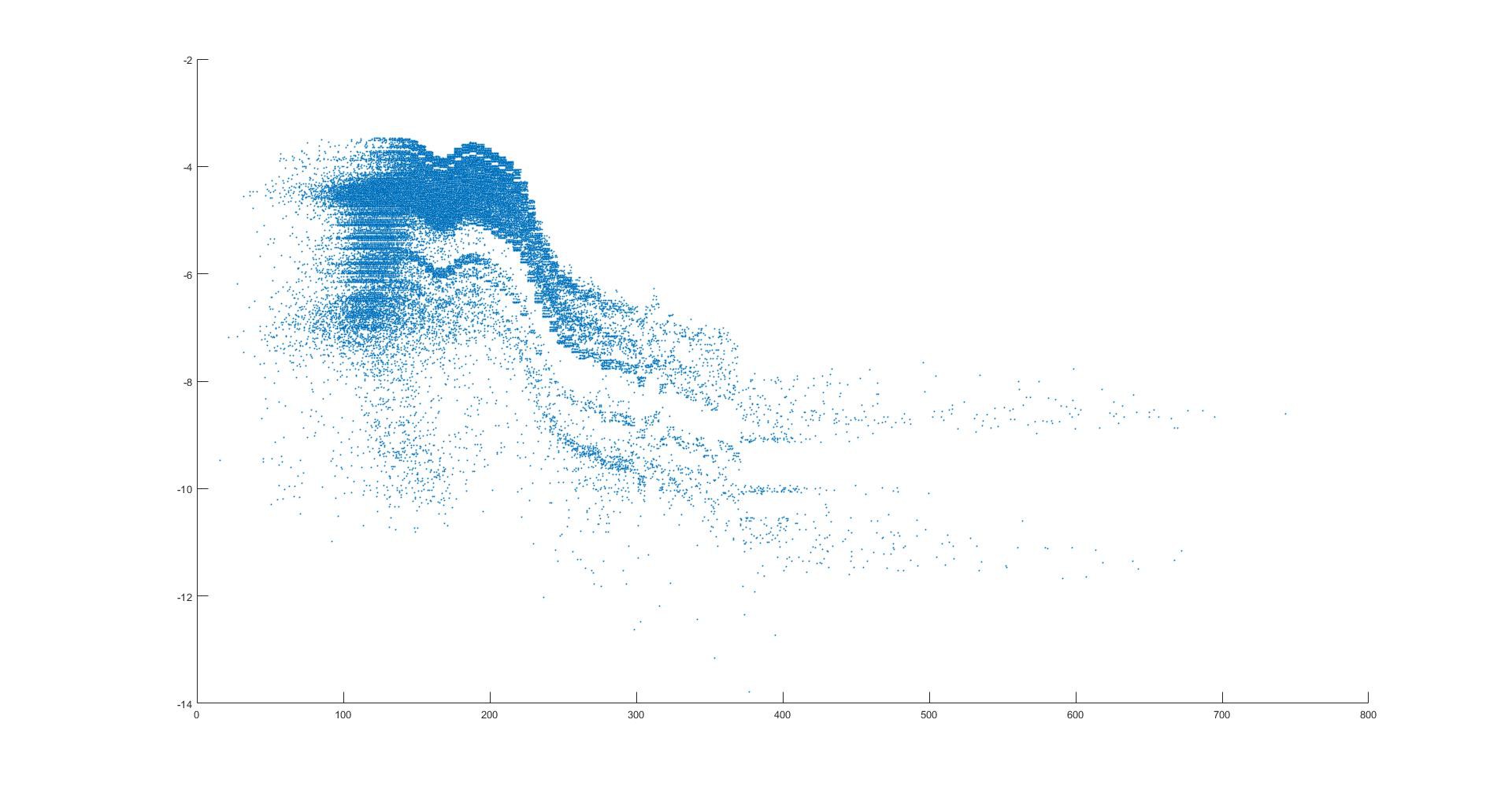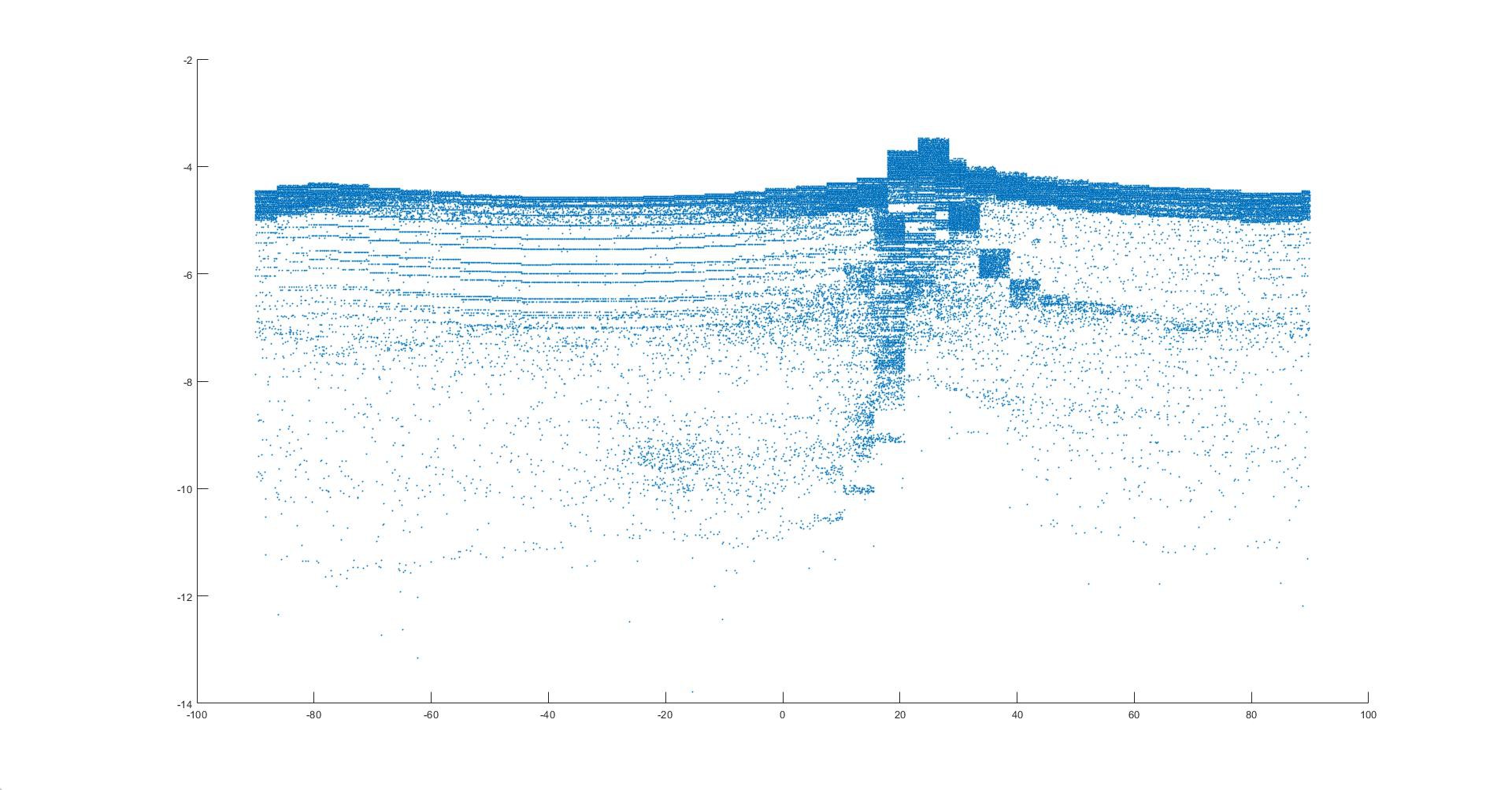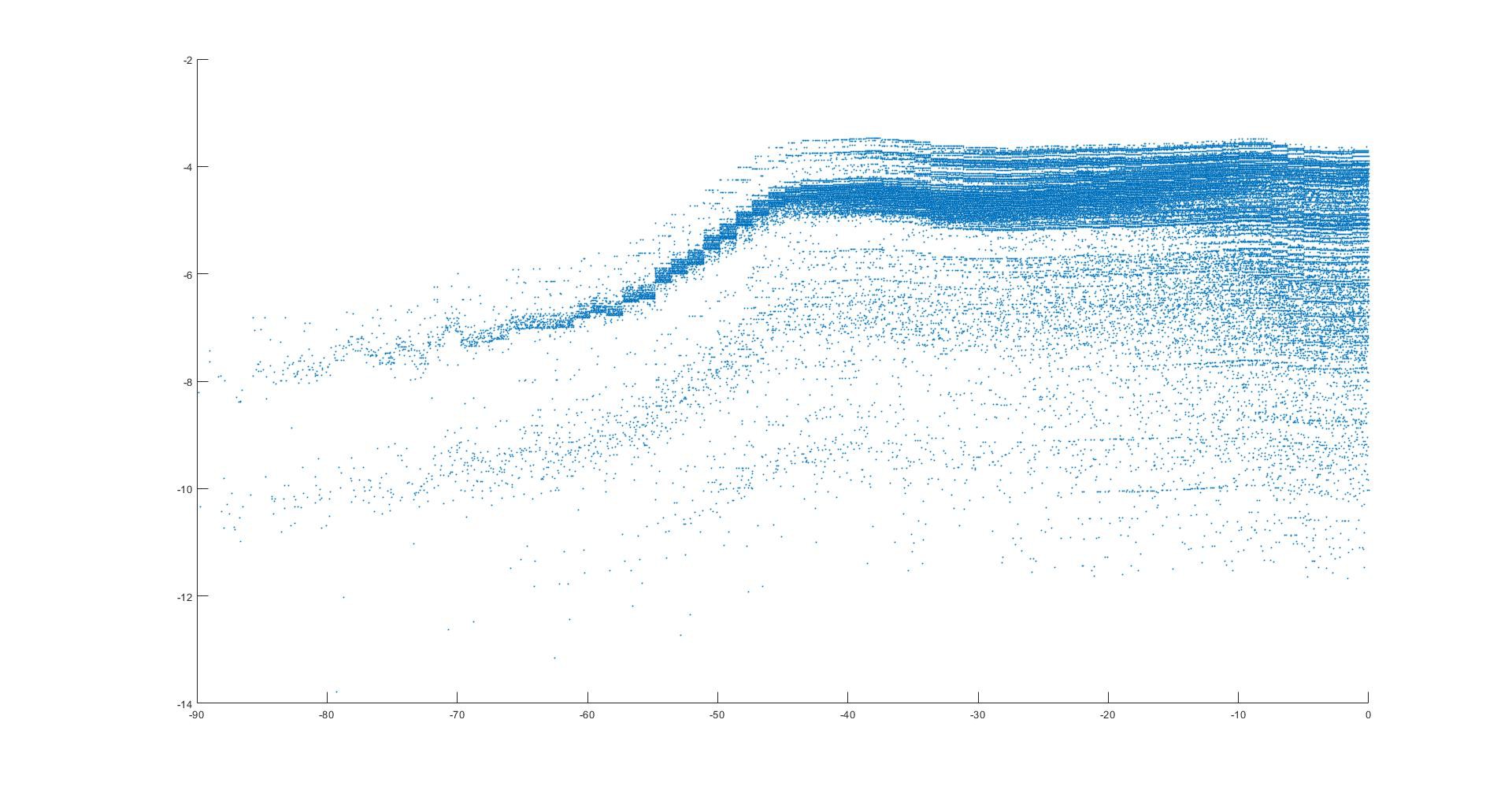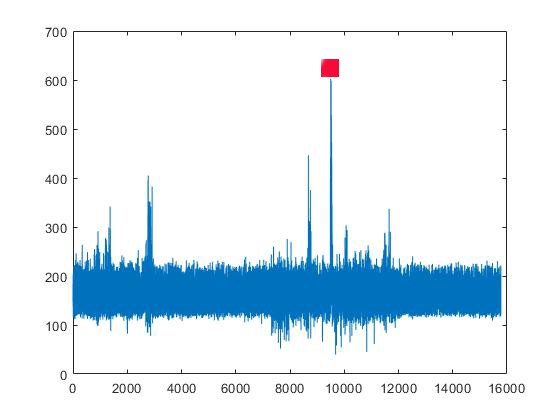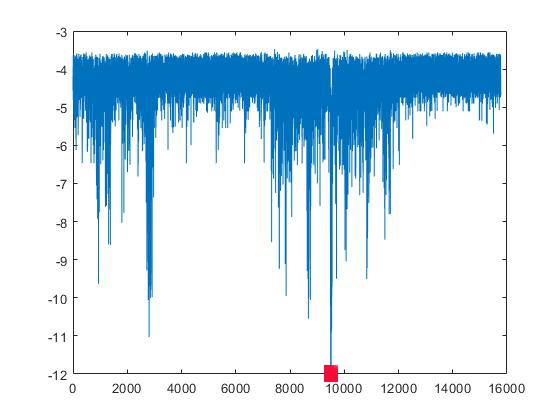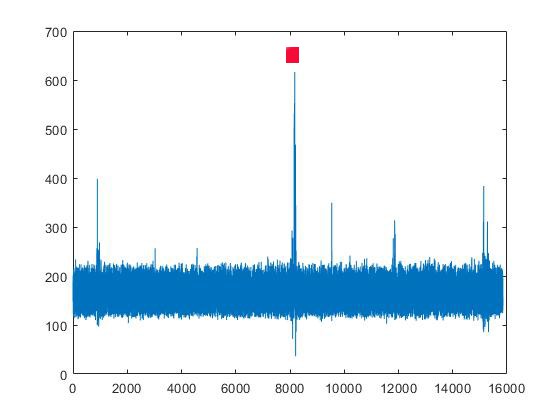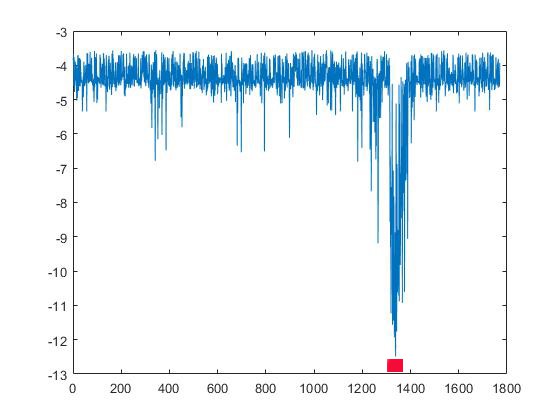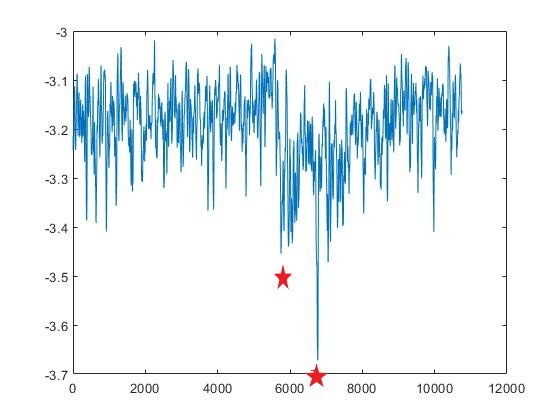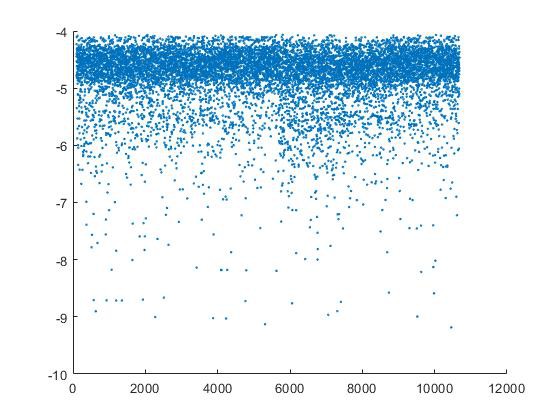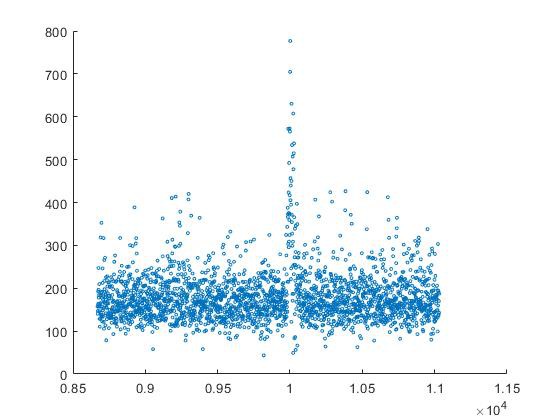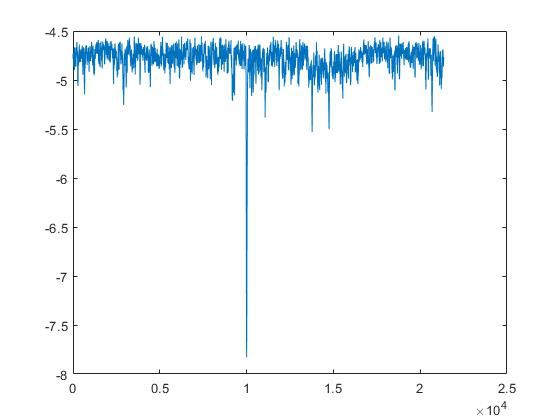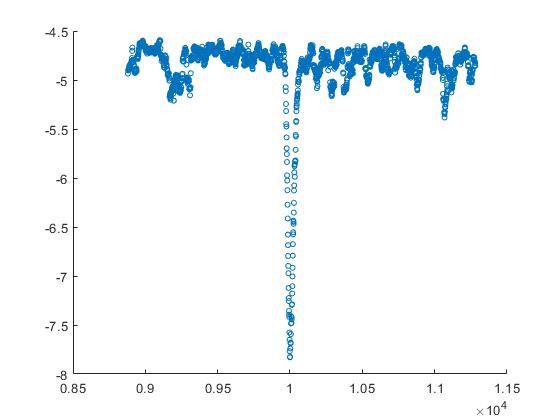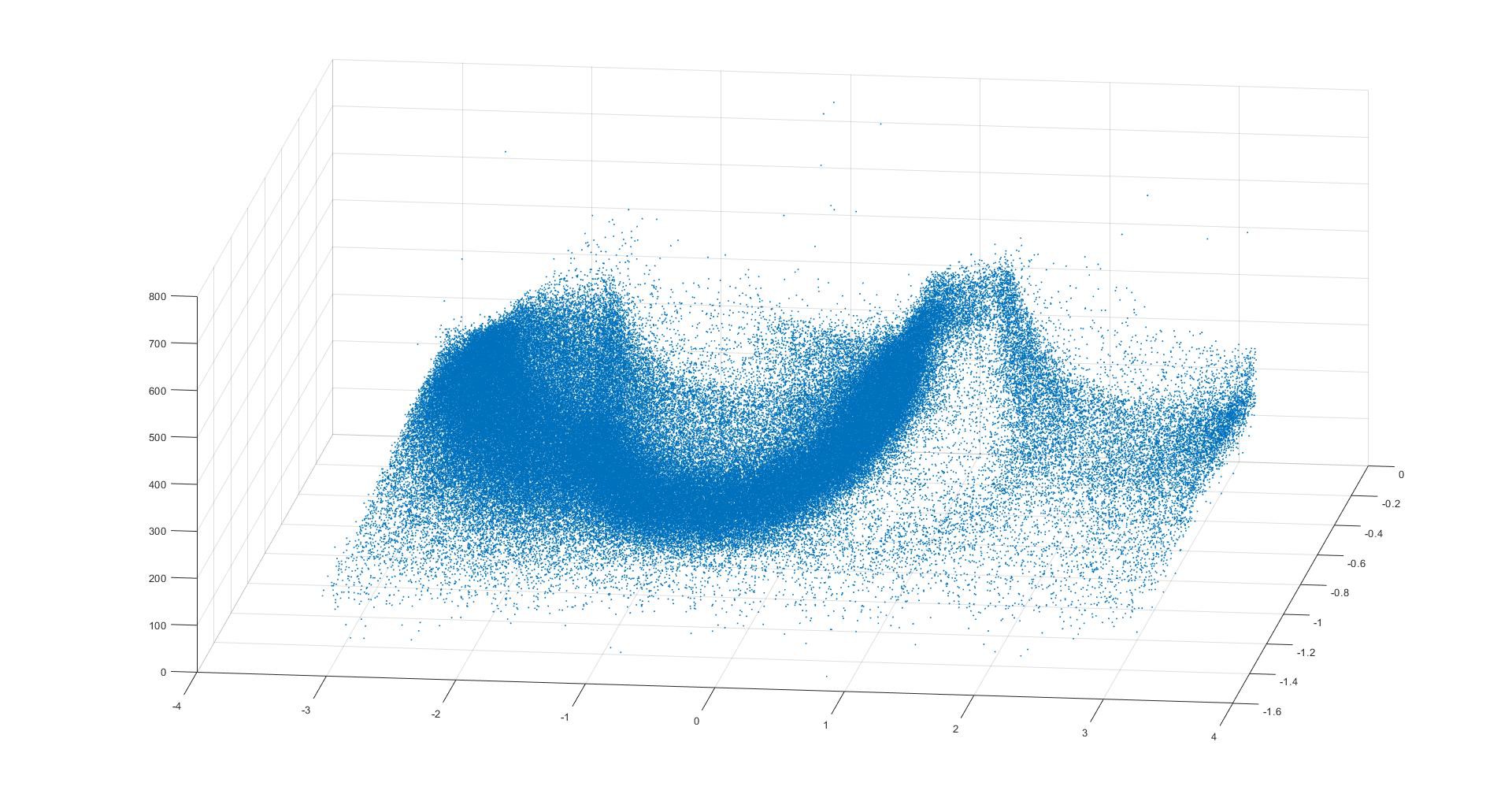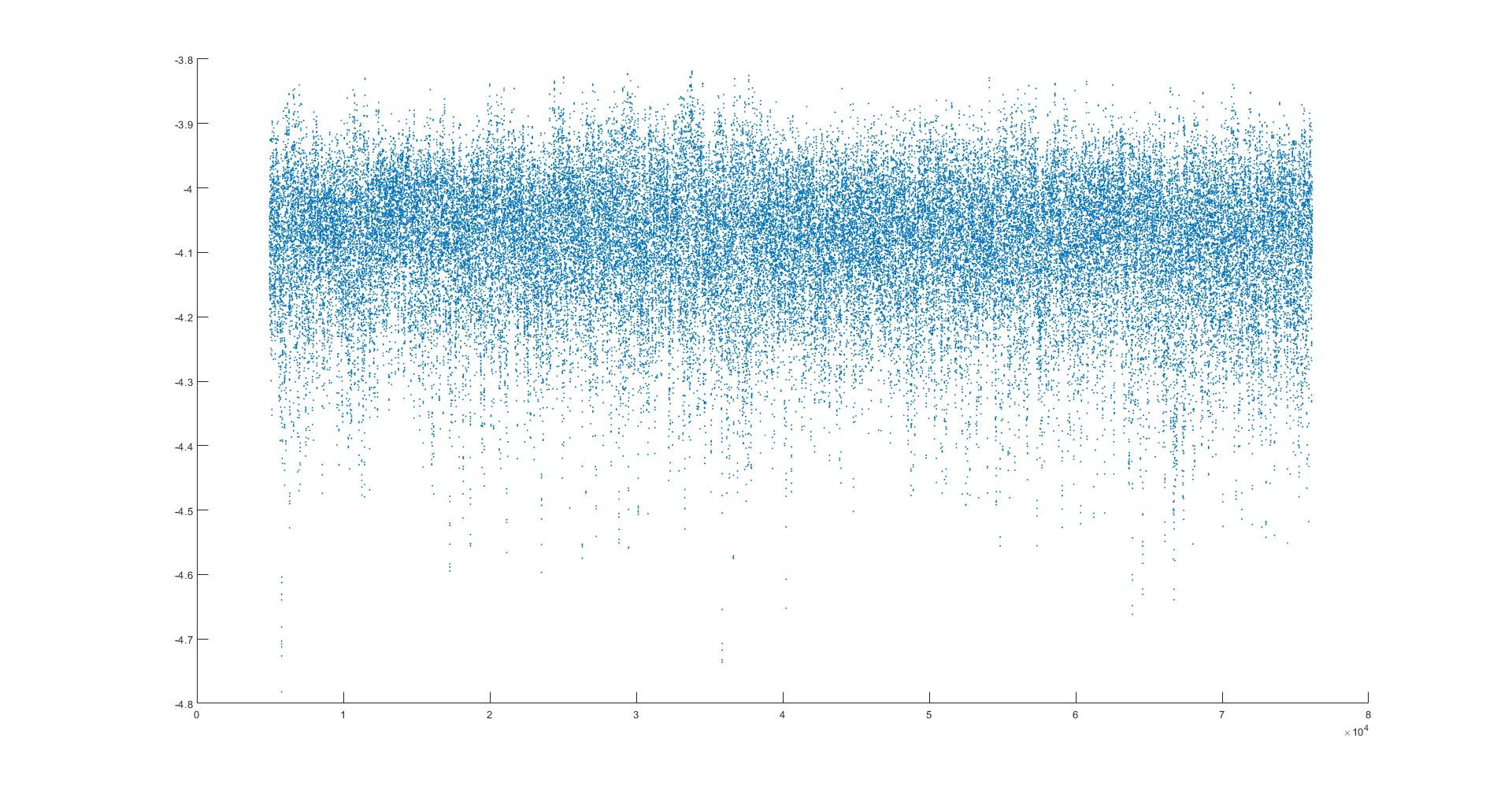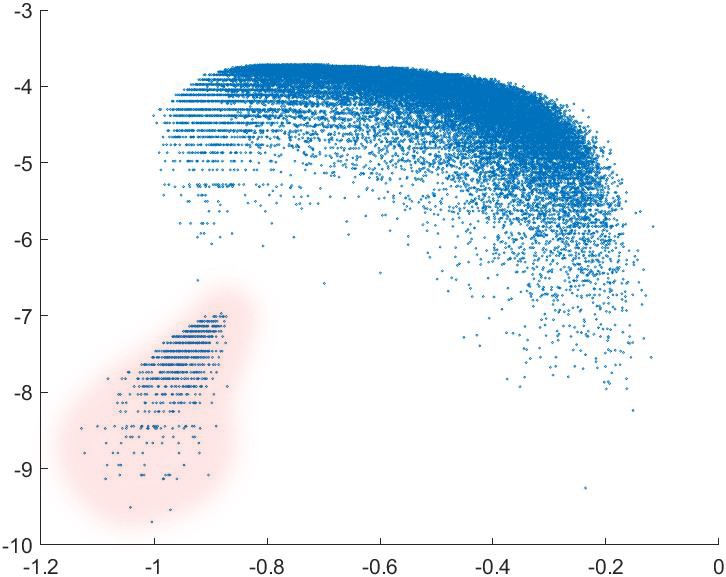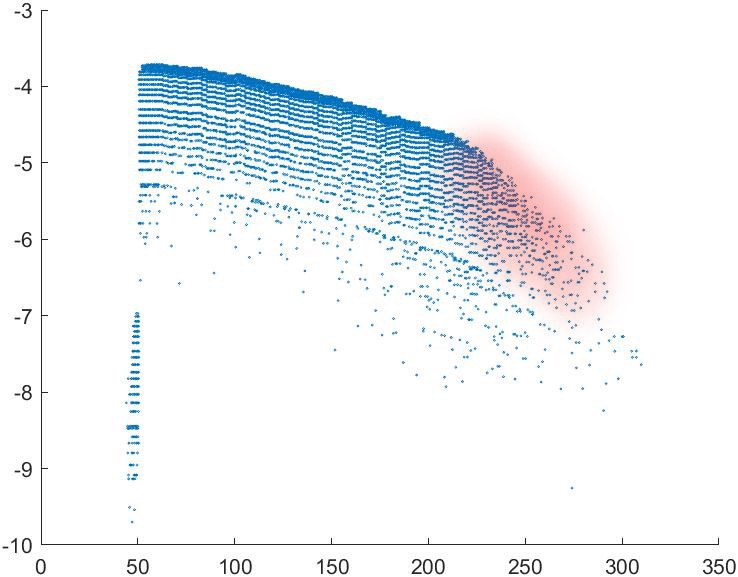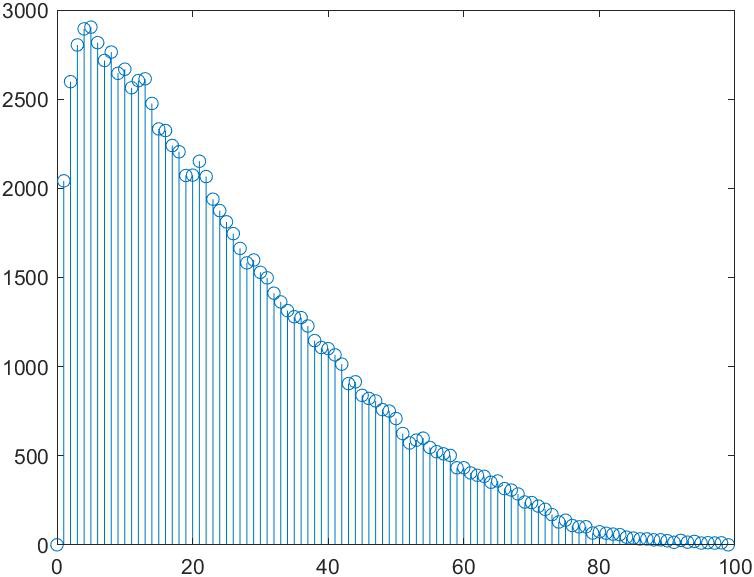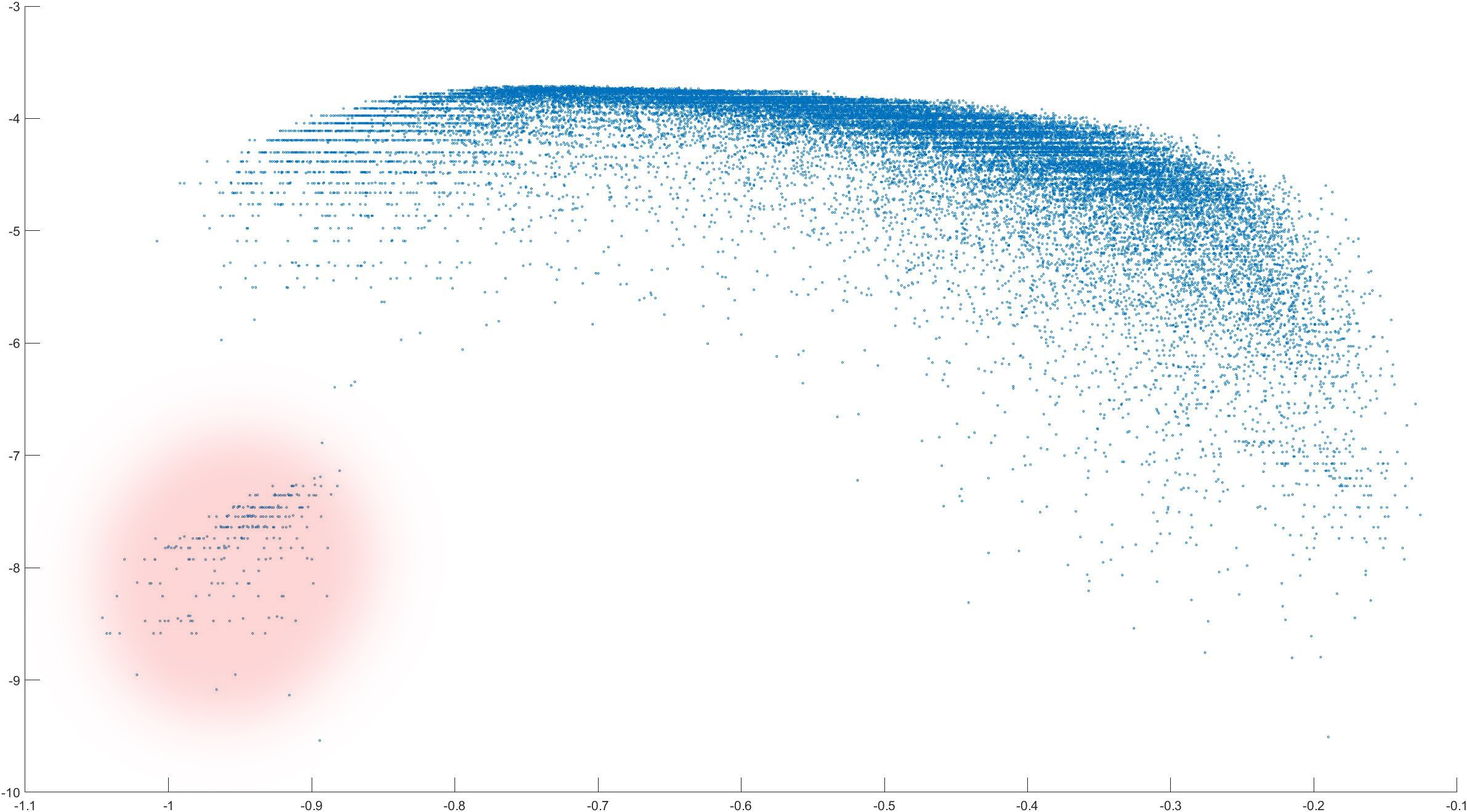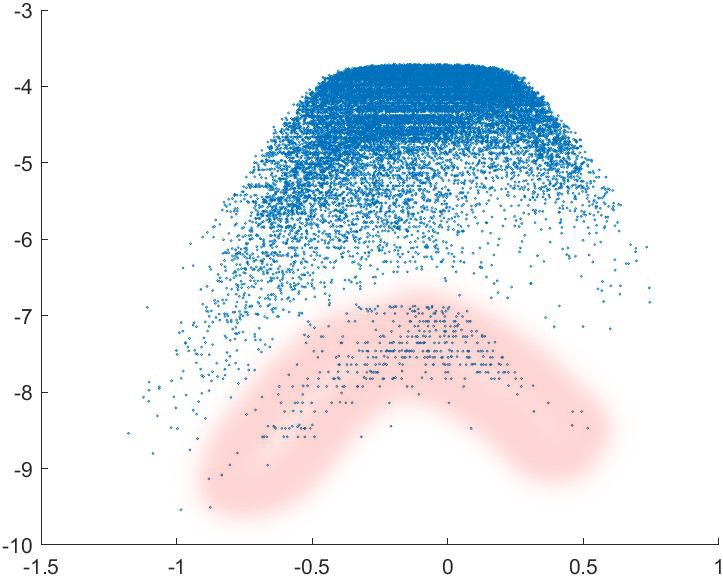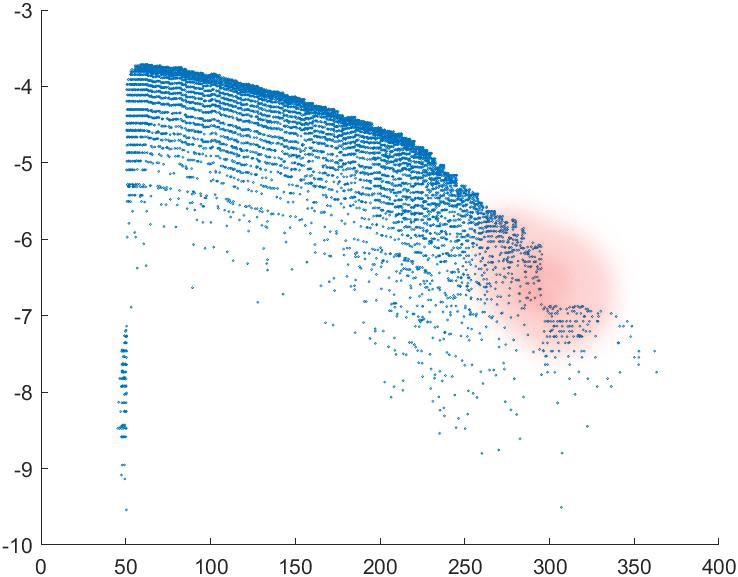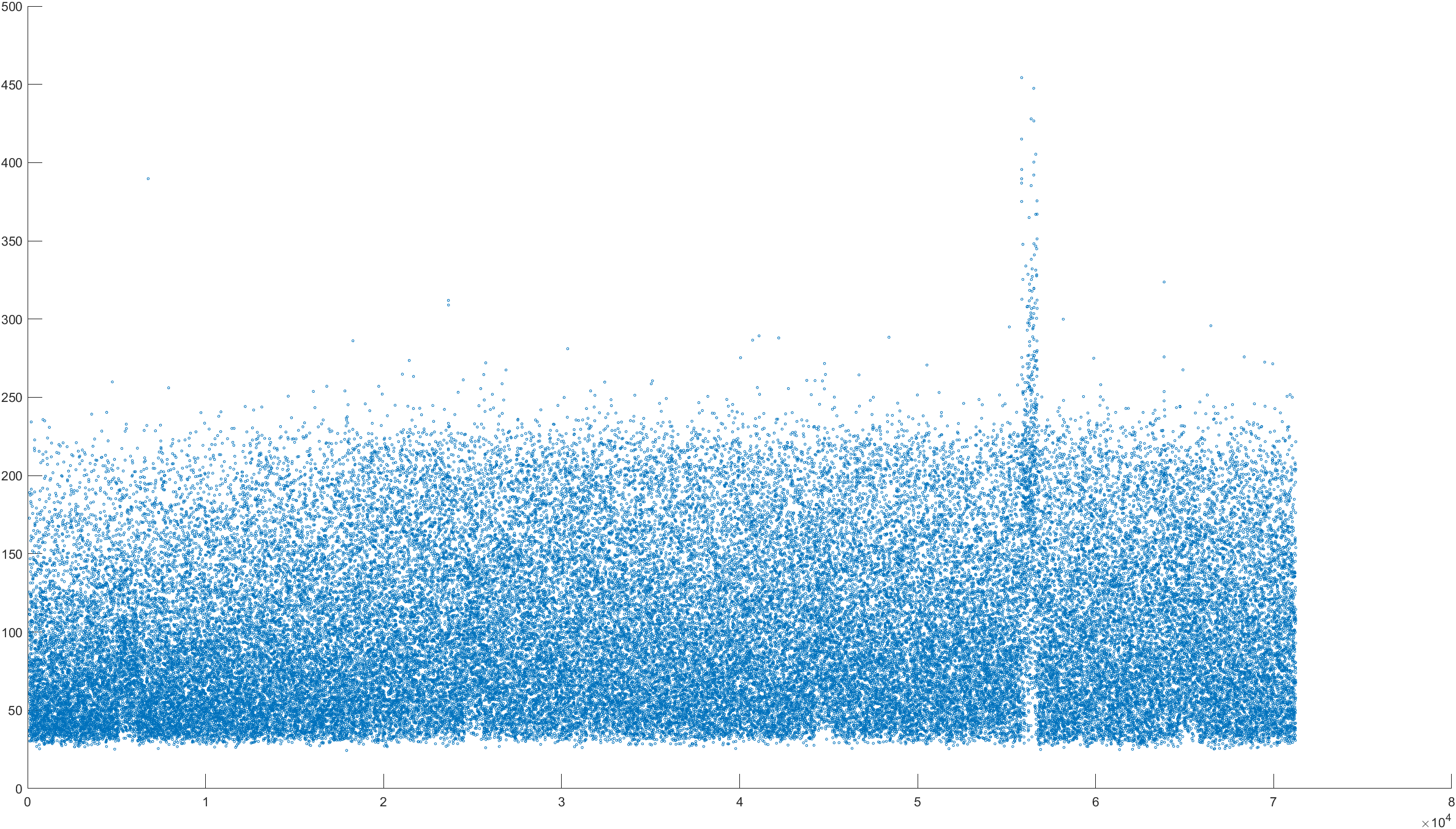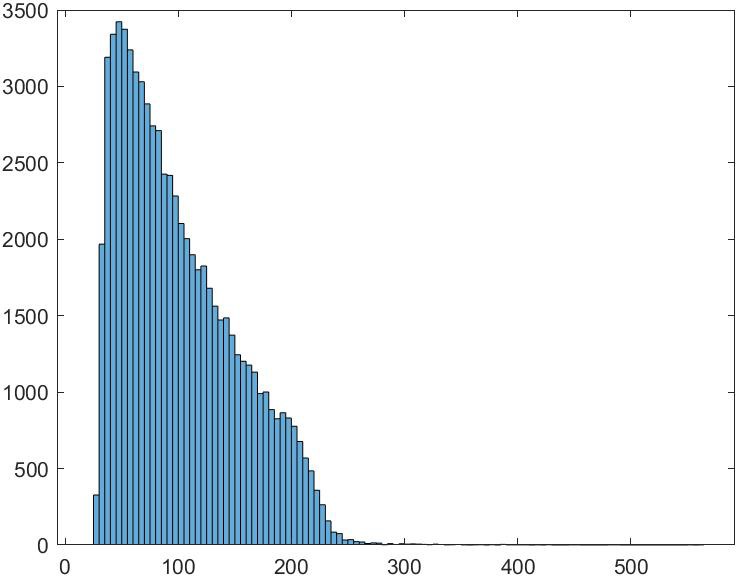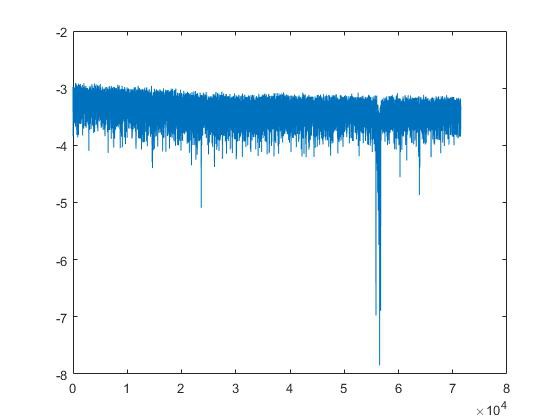-
Density Plot of Noise Axis vs. Magnitude
11/05/2020 at 08:09 • 0 commentsA density plot can give a better representation of the statistical distribution of the data points with respect to the compass axis. In this plot we are looking at axis of the surrounding noise vs. the vector magnitude of the noise at each time point. The data from 2 1/2 days from 12/24/20 to 12/26/2020 (967,873 time point rows by 13 data type columns) at the Yellowstone machine is represented here. The densityScatter function of Matlab assigns colors and contours to the data based on the density of the data points in the plot.
North/South is at zero degrees, East/West is at -90 and +90 degrees. The majority of the noise density (yellow and orange) is shown to be aligned in the general direction of the Yellowstone hot spot.
However, many of the higher magnitude points (axis from 30 degrees West to 60 degrees East) seem to be oriented toward the "Dillon" magma plume. Based on the work of others, this plume is believed to dive down through the crust on the East of our machine in a Northwesterly direction, from Yellowstone toward Dillon, Montana.
The possibility that the device is also detecting a component of low frequency noise from the turbulence of the Madison River itself has not been ruled out. The river runs roughly North/South and is located to the East of the machine. The river has been described as a "50 mile riffle" through the Madison Valley.

-
Major project upgrade and analysis of 950,579 Yellowstone data points
08/15/2020 at 14:30 • 0 commentsThe software for the Yellowstone machine has been remotely upgraded in a major revision. Data points are now also expressed in terms of their vector compass axis in addition to their compass direction origin. Time is now obtained periodically from an internet time server, as opposed to a local clock module for each data point. The use of a internet time server now allows for much better correlation with the multitude of other research seismometers in the Yellowstone region.
The device has also been even further protected against external power fluctuations by basing all analog sensor measurements on an internal voltage reference derived from the amplifier board itself.
The probability matrices are now based on 500,000 measurements and the initial sensor calibrations are based on the average of 48,000 measurements.
Probability matrices now assign each event to 75 "bins" for each measurement of vector magnitude, compass direction and depth. The software improvements now allow for an average of 4.1 data records per second.
The results are amazing.
The following data is from August 11, 12, 13 and 14 hours of August 14. There are 950,579 data points included in these graphs. There was no significant human activity nearby during this time period.
CLICK ON ANY OF THE IMAGES BELOW TO ENLARGE
This image from the University of Utah website gives the location of the device in relation to the local geography. The large lake in the bottom right is Yellowstone lake in the center of Yellowstone National Park. The yellow circles and squares are small earthquakes recorded over the 2 weeks prior to this post. The majority of the small earthquakes are SouthEast of the device.
The two small earthquakes to the immediate SouthWest of the machine are less than 10 miles from it. These local earthquakes are analyzed in some of the images below. The initial event was preceded by major anomalous seismic noise activity. The aftershock 12 hours later was not as well predicted.

The next image shows the dot plot of all of the vector magnitude data points for this time interval. 724 vector magnitude units is full scale for this device because the Yun uses a 10 bit A/D converter (1024 bits) and the amplifier output is centered at 512 bits. (No vector will be greater than the square root of 2 X 512 squared.)
Two local events are included in this data. They were reported to be Richter magnitude 1.5 and 1.7 by the University of Utah seismic program. They were about 12 hours apart in nearly the same location (immediately below the "machine" label on the map above.)

This is a zoomed in area of a portion of the dot plot above, showing a bimodal structure within the local noise. The repetitive signal is likely to be from a nearby pump. Even closer looks at this noise with moving mean averaging shows that a large portion of the overall noise is episodic - it is the composite of many small events. The bimodality seems to be clearly related to the fact that there are 2 sources of the noise - a constant, stronger noise from the Yellowstone area and the "global" noise from around the world.

The following image is a histogram clearly showing the bimodal distribution of the vector magnitude values. I believe that the bimodality is related to the fact that about 60% of the seismic noise seen by this machine is from around the globe and about 40% is from Yellowstone caldera related events.

The next histogram shows the distribution of data points as a function of depth in degrees from the horizontal. 90 degrees is vertical - straight down. There is a bimodal distribution seen here as well.

The next image shows a dot plot of the depth measurements. Due to the density of data points, the bimodality is harder to see in this format.

How does depth relate to vector magnitude? The next image shows this dot plot. There is a trend toward decreasing vector magnitude with increasing depth.

On closer look, there appears to be some unexplained fine structure in this data. The next 3 images are zoomed in views of this fine structure. The closely spaced parallel "lines" are probably the result of the coarseness of the 10 bit analog to digital converter in the Yun device, but there seems to be something larger happening as well.



The next image shows a histogram of the data points as a function of each vector's compass axis. Vibrations in the East - West line are on the -90 or +90 axes, vibrations on the SouthWest - NorthEast line are on the "-45 degree" axis, vibrations on the NorthWest - SouthEast direction are on the "45 degree" axis,, etc. A vibration exactly on the North - South line would be assigned to the 0 (zero) axis.. The peak of the histogram is +24 degrees - this is aligned very closely with the line between the machine and much of the macro-seismic activity as depicted in the University of Utah image above.

The next image is simply a dot plot of this same data. The seismic noise originating from the Yellowstone hot spot is amazingly consistent on this time scale.

How does the vector magnitude of the noise vary with axis direction? There is a faint "spur" in the data. Is it possibly related to distant activity in the Idaho seismic hot spot to the West?

The device saves the combined probability of each data point as well. It is on a logarithmic scale and it is the product of the individual probabilities of the vector magnitude, depth and axis of each data point. Here is a dot plot of the combined probability of each point in the data set. The horizontal lines are the result of the granularity of the "bins" in the probability matrices for the measured parameters. The two very local events pegged out at 10^-12 (one in a trillion chance that they were just noise, in other words.)

The next image depicts a 10 data point (4.1 seconds) moving average of the same data - it smooths out the horizontal banding but still shows the episodic nature of the low probability events.

Here is the histogram of the combined probability parameter.

How do the 3 measured parameters (vector magnitude, depth and axis) relate to one another? The X axis is horizontal vector origin axis, the Y axis is vertical vector origin depth and the Z axis is vector magnitude.

Here is the relationship between vector magnitude and the calculated combined probability statistic. The complexity of this graph is related to the input of the axis and depth probabilities to the combined statistic. The granularity of the chart when zoomed in is related to the limited number of probability bins (75) that the memory of Yun device will allow for each component of the combined probability

Here is the relationship between axis in degrees and combined probability statistic.

Here is the relationship between depth in degrees and the combined probability statistic.

Here is a 3D plot of the combined probability statistic (Z axis) vs. axis (Y axis) vs. vector magnitude (X axis.)

Here is a vector magnitude plot of the recent Richter magnitude 1.5 earthquake event about 10 miles from the machine on August 11 at 18:36:08 MDT. The event time is marked with a red box.

Here is a zoomed in view of the same data.

This is the plot of the NEARBY August 11 event's combined probability data. There is a considerable amount of activity before and after the event that does not appear in the magnitude data alone.

This is a plot of the vector magnitude data from the Richter magnitude 1.7 earthquake on August 12 at 06:30:40 MDT about 10 miles from the machine.

The combined probability data from this event:

Here is a zoomed in view of the probability data from that event. There is less surrounding activity than the initial event 12 hours before at the same location.

Fiber optic internet service will be available soon in the Madison Valley and this will allow for storage and analysis of data on a remote server, which will greatly increase the data output, The next stage of development will eliminate the computational limitations of the Arduino Yun device and its SD card storage medium.
The recent software improvements have led to much more resolution and a better definition of the seismic noise at the site of the device. Migration to an off-site processor with a better speed and memory capacity will eventually allow for more refined probability matrices (maybe 250 "bins" or so, resulting in less granularity in the probability calculations.) This should make for better understanding of the ambient noise on a second to second basis. This in turn will enable processing of the data from multiple devices as well, allowing for calculation of the absolute location at the intersection of tremor axes.
There continue to be strong hints that clusters of seismic noise vector analysis machines like this may one day be able to predict at least some local earthquakes.
-
Changes detected 5 minutes before small local tremor
05/18/2020 at 01:47 • 0 commentsA 1.4 magnitude tremor was detected North of the Madison Valley machine today at 11:36:55 MDT.
The USGS data can be found at:
https://earthquake.usgs.gov/earthquakes/eventpage/mb80423319/executive
Summary:
Magnitude 1.4 - 34km SSW of Three Forks, Montana
2020-05-17 17:36:55 (UTC) 45.618°N 111.753°W 0.4 km depth Event ID 80423319The following is a 10 second moving average of the combined probability data, with the first red star depicting the initial changes in probability statistic and the second start indicating the onset of the actual tremor, 336 seconds later. Data points are recorded from 11:00 to 12:00 every 333 msec in this plot.

These are the un-averaged probability data points from that time:

-
Hi Def Seismic noise and a significant local tremor.
05/17/2020 at 00:56 • 0 commentsOn 5/14/2020 at 21:56:00 UTC (3:56 PM local mountain time) a 2.4 magnitude tremor occurred close to the location of the Yellowstone area machine. The location as determined by the USGS was 44.955°N 111.710°W at 6.6 +/- 1.6 km depth. The event ID is 80422259. The USGS placed the location approximately 4 miles to the West of our device based on their remote regional seismic data but our device placed the signal axis directly to the North and South. The majority of the data collected before, after and during the event was in the linear part of the device's range.
In the last month the device has been remotely installed with new software. This is an extensive upgrade. Timing is now from internet time servers and improvements in SD card utilization now allow data readings every 333 milliseconds. The sensors are now calibrated for baseline and individual sensitivity differences at the time of startup. 200,000 data points are now collected at startup for the determination of the 3Dmagnitude, compass direction and depth probability arrays. The seismic noise background is now recorded in very high definition.
This a plot of the 3D magnitude data for 13 minutes around the event.

Here is a 10 second moving average of the combined probability statistic for the two hours around the event. There are 21,372 data points in this plot. Probability is in logarithmic format.

This is a closeup scatter plot of the 10 second moving average. The probability 'blip' prior to the main event precedes it by approximately 4 minutes.

This is a large pixel plot of compass direction vs. 3D magnitude. Red time points are those with magnitudes greater than 450. These are clustered around -pi radians, 0 radians and +pi radians. This indicates a North/South vector axis.

This is the promised hi def view of the local seismic noise over the 24 hours of 05/14/2020.. Compass radians (x axis, East to the left) vs. vs. depth radians (0 = horizontal, pi/2 = vertical) vs. 3Dmagnitude (millivolt units). 21,372 time points.

-
A Time Lapse of Seismic Noise Direction in The Yellowstone Region
04/13/2020 at 04:51 • 0 commentsHere is a time lapse video of the compass direction of the seismic noise in the Madison Valley of the Yellowstone region from March 4 to April 12 of this year. The seismic noise device was left undisturbed for the entire duration. One second time points were recorded. Noise values greater than 450 mV were excluded to eliminate the signals from the larger discrete local seismic events. The hourly files were concatenated into daily files. Matlab plots of noise direction (in +/- radians from North) vs. 3D noise magnitude were saved as 24 hour .tif files and the freeware Makeavi program was used to create a time lapse video of the 39 days. The center of Lake Yellowstone, under which the region's volcanic hot spot lies, is approximately 70 miles away and at about +2 radians relative to the device. There are clearly periods of increased activity both generally and from this direction lasting for extended times.
-
Yellowstone Seismic Noise Is A Composite Of Many Discrete Events
04/12/2020 at 02:57 • 0 commentsPlots of the moving average of the seismic noise probability data seem to show that the noise comes in discrete clusters of abnormal statistics. The following plot is a 10 second moving average of the 1 second combined noise probability data points. Click or double click on the image to see more detail.

Here is the compass direction of 24 hours of noise 3D magnitude in +/- degrees from North. East is to the left. North is 0 degrees and South is either + or - 180 degrees. Much of the noise originates from the West, with a strong concentration along the North/South axis. The device is roughly 70 miles Northwest of the center of Yellowstone lake.

-
Improvements to the program
03/15/2020 at 15:59 • 0 commentsImprovements to the startup self-calibration steps of the program have been made. This significantly improved the resolution of the device. Other major hardware improvement has been made by decreasing the second stage amplification of the charge amplifier and using a reference voltage to adjust for power supply noise. I will add details later.
I uploaded a video of the spatial distribution of the noise - it is in the files section.
https://cdn.hackaday.io/files/20735887126240/yellowstone%20noise%20slomo.mp4
-
"Fingerprinting" the local seismic noise in the Yellowstone area
02/06/2020 at 01:53 • 0 commentsThe data from the last log entry was collected on Feb. 3, 2020. This log shows about 19 hours of data from today, Feb. 5, 2020. The unusual features of the last plot are highlighted again to show the similarities from day to day.
First, the plot of the angular depth vs. combined probability statistic -

Next, the plot of the compass direction vs. the combined probability statistic -

Finally, the plot of 3D magnitude vs. the combined probability statistic.

Lots of persistence of the unique features of this noise data. Now - how to use this?
There was a request for a graph of what the 3D magnitude and angular location probability arrays look like. The following two graphs show how 102,000 data points sort out into their 100 respective probability "bins."
First, the 3D magnitude probability array -

Next, the angular location probability array -

-
Looking at the fine points
02/03/2020 at 14:25 • 0 commentsThe probability data really shows some interesting features. Again, the probability parameter of each 1 second data point is affected by the 3D magnitude, the averaged compass direction and the angular depth of that data point. It is clear that these 3 parameters are inter-related as well. The display of these individual data parameters against the probability statistic shows an interesting subpopulation of noise events.
This is a plot of angular depth (X axis) vs. probability statistic for Yellowstone data from the last 9 1/2 hours. There is a clustering of data points at around -1 radians of depth that is clearly separate from the rest of the data.
The "steps" in the combined probability data relate to the fact that the magnitude and vector origin probabilities are stored in discrete "bins" that are not continuous.

Next is the same data set showing compass direction - another cluster of points is seen, but their compass locations do not seem to be out of the ordinary. The discrepancy must therefore be related to magnitude or angular depth.

Next is a plot of 3D magnitude vs. the overall probability statistic. There is a break in the data at the higher magnitudes. Something seems to be "pushing down" the probabilities of points that "should have been" in the -6 to -7 range. If these are the same misplaced points as in the plot immediately above, it sounds like the data points with anomalous angular depth (from the first plot) may explain the discrepancies.

What does all of this mean? More to follow as I try to figure it all out!
-
Data from the Yellowstone area - FINALLY
02/02/2020 at 15:24 • 0 commentsThe seismic noise device placed in the Madison Valley East-Northeast from the Yellowstone caldera has been turning out reams of data. The amount of seismic noise in this area is astounding. It is 4 or 5 times as intense as the noise recorded by the same machine in East Tennessee. Much of the noise seems to be coming from the West, interestingly. The stronger noise is originating closer to the horizon and the less intense noise is deeper. Several strong local events have been recorded. The device is indoors in a climate controlled environment and it is possible that there may be data artefacts from the vibrations from the heating system. A future visit to Montana will be needed to eliminate this issue. Another source of noise may be the Madison river itself - it is about 200 yards to the East of the current location of the device.
Here is a representative 24 hour plot of the vector magnitude data showing a local event. Full scale for vector magnitude would be about 650.

This is the same data, expressed as a scatter plot. I believe that he small blips along the bottom of the plot may be related to the indoor heater coming on and off.

Next is the 3D vector magnitude data expressed as a histogram. The nice Gaussian-like distribution seen in Tennessee is not seen! This data seems to reflect at least 2 independent sources of the noise.

Here is a plot of the combined (multiplied) vector magnitude probability and 3D location probability (Y axis) of each time point during the same time interval. 10^-8 is one in 100 million.

Next is a plot of angular depth vs. vector magnitude over a 24 hour period. Depth is expressed in radians from the horizon. Zero is at the horizon. - Pi/2 would be straight down. Higher intensity time points tend (seem) to come from a direction near the horizon. At this point, the device is not fully calibrated and the angular depth cannot be considered to be precise.

The next video is the 3D plot of compass direction vs. angular depth vs. combined probability parameter for a 24 hour period.
Device for Seismic Noise Analysis
Could a digital device to analyze the statistics of the magnitude and 3-D origins of seismic noise predict some local earthquakes?
 Michael Doody
Michael Doody